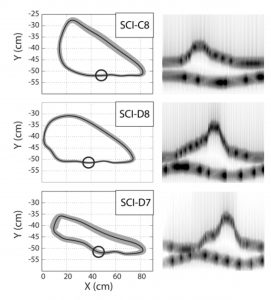In this research, we tried to explore the potentials of interactive sonification in the area of motor rehabilitations. Most of the systems use sound like a rewarding element, or to create an ambiance in Virtual Reality environment.
Assistive technologies in motor rehabilitation are usually characterized by robotic systems and exoskeletons. Such systems are heavy, expensive, and require constant assistance. Real-time sonification of movements can be a straightforward, easy, and also affordable way, to conduct and assist rehabilitation’s tasks. The movement of the patient, monitored through sensors attached to his/her limbs, is translated into a sound space that changes accordingly.
Our goal was to try to ‘replace’ a robotic system for lower-limb motor rehabilitation with an interactive sonification.
In order to test our concept we took original recordings of movements (performed by a patient with the help of a robot) and applied on a sonification system developed by the author.
This system consists of mapping the movement into the sound space of human vowels, which are synthesized in real-time. Vowels represent the first sound that humans recognize (and try to imitate) in their very first period of life. Because of these characteristics, such sounds seems a good candidate for rehabilitation in older and young patients, and people that need to undergo a rehabilitation process after an important injury. Our results suggest that sonification can be very powerful in highlighting errors and helping patients to adapt and correct autonomously.
Correct movement
Error
Incorrect movement
Publications:
Alberto Boem, Sergio Canazza Targon, and Antonio Rodà. Progettazione e realizzazione di un Auditory Display per la riabilitazione motoria. In Proceedings of the XVII Colloquio di Informatica Musicale (CIM 2010), Torino (IT), 5 – 8.10.2010. [link to the pdf – Italian version only]
